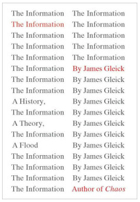Publishers Weekly review on Amazon:
 “In 1948, Bell Laboratories announced the invention of the electronic semiconductor and its revolutionary ability to do anything a vacuum tube could do but more efficiently. While the revolution in communications was taking these steps, Bell Labs scientist Claude Shannon helped to write a monograph for them, A Mathematical Theory of Communication, in which he coined the word bit to name a fundamental unit of computer information. As bestselling author Gleick (Chaos) astutely argues, Shannon’s neologism profoundly changed our view of the world; his brilliant work introduced us to the notion that a tiny piece of hardware could transmit messages that contained meaning and that a physical unit, a bit, could measure a quality as elusive as information. Shannon’s story is only one of many in this sprawling history of information. Gleick’s exceptional history of culture concludes that information is indeed the blood, the fuel, and the vital principle on which our world runs.”
“In 1948, Bell Laboratories announced the invention of the electronic semiconductor and its revolutionary ability to do anything a vacuum tube could do but more efficiently. While the revolution in communications was taking these steps, Bell Labs scientist Claude Shannon helped to write a monograph for them, A Mathematical Theory of Communication, in which he coined the word bit to name a fundamental unit of computer information. As bestselling author Gleick (Chaos) astutely argues, Shannon’s neologism profoundly changed our view of the world; his brilliant work introduced us to the notion that a tiny piece of hardware could transmit messages that contained meaning and that a physical unit, a bit, could measure a quality as elusive as information. Shannon’s story is only one of many in this sprawling history of information. Gleick’s exceptional history of culture concludes that information is indeed the blood, the fuel, and the vital principle on which our world runs.”
The following got some highlighter during my read:
“In the long run, history is the story of information becoming aware of itself.” pg 12
“With words we begin to leave traces behind us like breadcrumbs: memories in symbols for others to follow.” pg 31
“All known alphabets, used today or found buried on tablets and stone, descend from the same original ancestor.” pg 33
“The written word was a prerequisite for conscious thought as we understand it.” pg 37
“It is a twisting journey from things to words, from words to categories to metaphor and logic.” pg 39
“If the ideal of communication is a meeting of souls, then writing is a sad shadow of the ideal.” pg 48
“And the atom of knowledge was the word.” pg 50
“The word lyrics, did not exist until the nineteenth century.” pg 76
“Like the printing press, the telegraph, and the telephone before it, the Internet is transforming the language simply by transmitting information differently. What make cyberspace different from all previous information technologies is its intermixing of scales from the largest to the smallest without prejudice, broadcasting to the millions, narrowcasting to groups, instant messaging one to one.” pg 77
“A message had seemed to be a physical object. That was always an illusion; now people needed consciously to divorce their conception of the message from the paper on which it was written.” pg 151
“A message sent by telegraph had first to be written, encoded, and tapped out by a trained intermediary. To employ the telephone, one just talked. A child could use it. For that very reason it seemed like a toy. … Business people thought it unserious. Where the telegraph dealt in facts and numbers, the telephone appealed to emotions.” pg 189
“DNA: A Library of Alexandria that keeps its data safe by copying itself billions of times.” pg 296
“Most of the biosphere cannot see the infosphere; it is invisible, a parallel universe humming with ghostly inhabitants. … We are aware of the many spices of information. We name their types sardonically, as though to reassure ourselves that we understand; urban myths and zombie lies. We keep them alive in air-conditioned server farms. But we cannot own them.” pg 323
“The track of every canoe remains somewhere in the oceans.” pg 376
“Every word ever said, whether heard by a hundred listeners or none, far from having vanished into the air, leaves its indelible mark, the complete record of human utterance being encrypted by the laws of motion and capable, in theory, of being recovered — given enough computing power.” pg 376
“Impossible as it seems, the modern world is running out of names.” pg 388
“All traditional ideas of privacy, based on doors and locks, physical remoteness and invisibility, are upended in the cloud.” pg 396
“When information is cheap, attention becomes expensive.” pg 410
